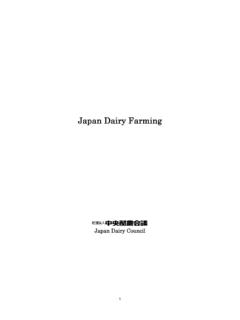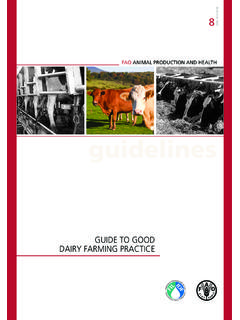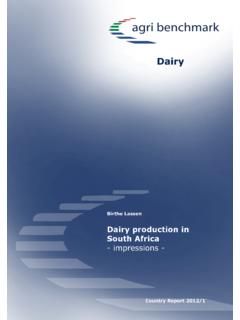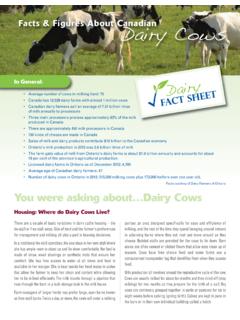Transcription of 3. Current situation of Japanese dairy farming
1 113. Current situation of Japanese dairy farming Japanese dairy farming with the advance of intensification and expansion The Japanese agricultural production in 2010 was approximately 8 trillion jpy, of which milk production was accounted for around 10%. Fig 1 :Agricultural production / output (2010) Resources : Production agriculture income statistics by Ministry of Agriculture, Forestry and Fiesheries. Commercial dairy farming had started about 100 years ago in Japan, and it started developing in full scale when school lunch was introduced in primary schools. Compared to the rice and vegetable growing, dairy farming had a benefit of generating income monthly and consistently despite of the weather conditions. For those reasons dairy farming grew its popularity rapidly, however, in those days farmers still grew rice and vegetables and kept a smaller herd of just 2-3 cows. In 1965 average herd size per farm was only cows, and annual production yield was millions tonnes.
2 With Japan's economical growth, many young people had moved from the countryside to cities. This has resulted in the shortage of successors, agriculture as a whole had to advance towards rationalization, intensification and expansion in their size. dairy was no different. In 1963 at its peak, there were 418,000 dairy farms in Japan, but since then the numbers had declined rapidly to about 160,000 in 1975 and only 82,000 in 1985. With this trend continuing, about 4-5% dairy farmers leave farming every year, and in 2012 there were only 20,000 farms left which was only one twentieth of the numbers at its peak time. On contrary, the herd size continued to be increased, the scale of Japanese dairy farms became almost equal to the EU member states which are the leading dairy countries. table 1 In 2012 the average herd Agricultural trillion trillion Cattle18%Raw Milk30%Poultry29%Pig21% 12size of Japanese farm was , and annual raw milk production was million tones.
3 Table 2 With this increased herd size securing its supply, raw milk is used approximately 54% for drinking milk and 45% for processed dairy products such as cheese and table 3 Table 1: International Comparison of dairy farming (2010) Resources IDF World dairy situation AMI Marktbilamz Milch 2011 CDC ANNUAL REPORT USDA Milk Production Farms,Land in Farms, and Livestock Operations DairyAustralia Australian dairy Industry In Focus 2011 LIC dairy Statistic 2010/2011 Livestock Statistics, Milk Products Statistics, Statistics of Agricultural Products prices by Ministry of Agriculture, Forestry and Fiesheries. Note: Figures for Hokkaido Japan is of 2010. Currency exchange rate by Mitsubishi Tokyo UFJ Bank (TTS Market) is used For Raw Milk production and Average production yield per cow, figures were calculated using 1 pound= for USA, 1 litre= for Australia and NZ. Table 2: Number of dairy farms and cows by year Resources: Livestock statistics, Annual Statistics on dairy farms and cows UnitNetherlands France Germany Denmark UK Canada USA Australia NZ Japan HokkaidoNumber of parous cows10001,479 3,729 4,182 573 1,847 987 9,117 1,600 4,397 933 480 Number of Farms100020 82 90 4 16 13 63 7 12 21 8 Number of parous cows per farm 75 45 46 133 117 76 146 230 386 44 64 Raw Milk Production Cost1000t11,941 24,000 29,610 4,965 13,935 8,434 86,769 9,374 17,859 7,631 3,897 Average production yield per cowkg7,440 6,657 7,113 8,589 7,501 9,768 9,517 5,871 3.
4 944 8,046 8,045 Volume of dairy cheese1000t753 1,756 2,169 292 335 349 4,742 333 282 123 18 Products butter1000t181 409 449 33 119 83 709 132 478 82 69 SMP1000t64 320 261 27 66 72 824 244 363 170 144 Consumption per Drinking -person -Farm-gate price of raw of cowsOver 2 years oldYear Numbr of Parous cowsNumber of Number ofFarms Total total
5 Subtotal Milking cow Dry cow farms cows 1963 417,640 1,145,370 729,170 636,240 538,310 .. 416,200 307,600 1,804,000 1,198,000 1,060,000 884,900 174,900 606,600 160,100 1,787,000 1,235,000 1,111,000 910,000 200,900 549,700 100,032 1,829,343 1,324,911 .. 504,432 .. 82,400 2,111,000 .. 1,322,000 1,101,000 .. 648,600 63,300 2,058,000 .. 1,285,000 1,081,000 204,700 .. 44,300 1,951,000 1,342,000 1,213,000 1,034,000 178,700 609,700 33,600 1,764,000 1,251,000 1,150,000 991,800 157,900 513,200 32,200 1,725,000 1,221,000 1,124,000 971,300 153,100 504,700 31,000 1,726,000 1,219,000 1,126,000 966,100 160,300 506,700 29,800 1,719,000 1,210,000 1,121,000 964,200 156,400 508,900 28,800 1,690,000 1,180,000 1,088,000 935,800 152,000 602,600 27,700 1,655,000 1,145,000 1,055,000 910,100 144,900 510,200 26.
6 600 1,636,000 1,130,000 1,046,000 900,000 146,100 505,300 25 400 1 592 000 1 093 000 1 011 000 871 200 140 100 499 600 24,400 1,533,000 1,075,000 998,200 861,500 136,700 458,000 23,100 1,500,000 1,055,000 985,200 848,000 137,200 445,100 21,900 1,484,000 1,029,000 963,800 829,700 134,100 454,900 21,000 1,467,000 999,600 932,900 804,700 128,200 467,800 20,100 1,449,000 1,012,000 942,600 812,700 129,900 436,700 ofcows perfarmchange from previousUnder 2years old 13 Table 3: Milk Products Statistics Resources: Milk Products Statistics, by Ministry of Agriculture, Forestry and Fiesheries.
7 For Drinkingmilk, ratioFor Dairyproductscomponent ratioOtherscomponent ratio7,881,390 4,218,563 3,586,821 76,006 ,631,304 4,109,761 3,451,217 70,326 ,533,851 4,082,808 3,387,420 63,623 numberProcessed amount by usesraw milkproductioncomponentratio 14 Family run business Unlike corporate managed beef cattle, pig and poultry farms, the characteristics of Japanese dairy farm management is its heavily reliance on family labour. About 85% of dairy farmers are not company registered (unincorporated), table 4 and about 80% employ no full time workers. table 5 These figures clearly show that dairy farms in Japan heavily rely on family labour.
8 Cows have very delicate nerves like humans, so farmers have no choice but work along with their physiology. Such 24 hours 365 days care could have been only available by family run business. This trend is a feature seen not just in Japan but also in all other leading dairy countries. Table 4: Management Style Table 5: Number of employees outside family Resources: National Basic Research of dairy farming Number ofDairy farms1 Corporationper farmJointCorpoprationNotcompany-register edNon-responseCorporationManagement2,696 933 total 1,763 435 548 88 65 - 144 - 95 101 - - 77 - 298 Researcg Total 2,635 86 012345 9 Over 10 Non-responseTotalexcluding 0and non-response Validresponseincluding0 Averagewithout 02.
9 696 933 total 1,763 435 548 65 144 95 101 77 298
10 Research total 2,635 of dairy FarmsUnit Number, 15 Facilities on the farm Barn There are two major methods to keep cattle on the farm, by tying them up or by loose-housing, and barn plans are different accordingly. Stall barn A stall is the space allocated for each cow, and in the stall barn each cow is tied up in a stall. A stall barn does not require big space, and majority of Japanese farms use this system. This might be a little cramped for cows, but there are some benefits also as farmers do not have to worry about cows fighting with each other, they can pay attention to individual animal, and it is easier to check their health. On the other hand, cows cannot move about by themselves, so it requires more labour in milking and feeding. In this style, the herd size is generally around 50 cows.







